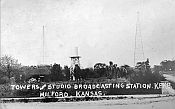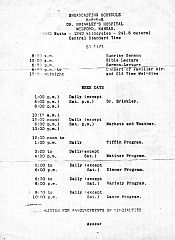|
www.theradiohistorian.org
Copyright
2025 - John F. Schneider
& Associates, LLC
[Return
to Home Page]
(Click
on photos to enlarge)
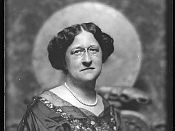
Evangeline Adams was an astrologer who broadcast
nationwide over the CBS network in 1930.
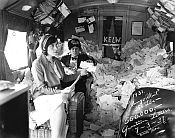
KELW’s “Daddy Rango” and his assistant posed
inside his traveling radio bus, overflowing with letters from his
listeners.

Daddy Rango program ad
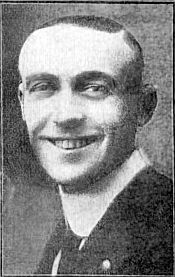
Ralph Richards
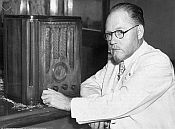
John R. Brinkley
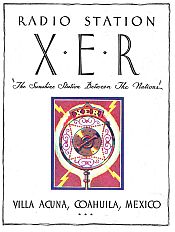
Cover of an XER promotional booklet, 1931
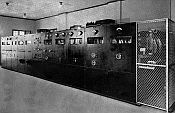
XER's original 150 kW transmitter
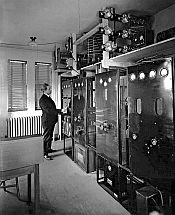
Norman Baker and KTNT's transmitter
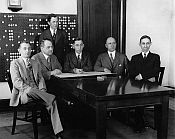
Members of the Federal Radio Commission, formed
by Congress in 1927.
|
|
RADIO - A NEW OPPORTUNITIES FOR SCAM ARTISTS:
In 1922, radio broadcasting exploded in the United States
virtually overnight. This new form of
entertainment and communication burst upon the scene and was quickly embraced
by millions of Americans. Its sudden growth
was comparable to the overnight adoption of the Internet in our lifetimes. And just like the Internet, radio in its
early years proved to be fertile ground for hundreds of unscrupulous
characters, crooks and shysters. It took
the determined action of the nascent Federal Radio Commission (and later on,
the Mexican government) to clean up the airwaves and clear the way for an
honorable and successful broadcasting industry.
Here are a few stories of some of the scoundrels that plied the airwaves
of the 1920’s.
ASTROLOGISTS, FORTUNE TELLERS, NUMEROLOGISTS AND MIND READERS
At the start of the Great Depression, astrology was experiencing
a sudden surge in popularity. Once limited
to the fringes of society, the practice suddenly found mainstream popularity as
people, disillusioned by society’s downturn, started searching for alternative explanations
for life's uncertainties. The boom started
when newspapers began publishing daily horoscopes, offering vague predictions and
advice for each zodiac sign. It was only
a matter of time before radio would join the bandwagon.
It began innocently enough.
Leona Lamar was probably radio’s first spiritualist. She broadcast for a few weeks over Boston’s WNAC
in 1924, answering mailed-in questions. The following year she was heard on WHN in New
York. Then, starting in 1930, New York astrologer
Evangeline Adams gained a large national following, being heard three times weekly
over the CBS network. She offered her personalized
readings and predictions to listeners who wrote in by the thousands. At the height of her popularity, Adams reportedly received 4,000 reading requests
a day and employed dozens of assistants to open and answer her mail.
Small-time radio stations quickly took notice of Davis’s success
and began looking for the own broadcast astrologers. In these years before the acceptance of radio
advertising, any program that generated revenue was a draw. This unfortunately led to the hiring of many charlatans,
who saw radio astrology as a way to make a quick buck by fleecing their listeners. For decades, vaudeville theatre had presented
a wide assortment of fortune tellers, psychics, spiritualists and mind-readers. They were frequently presented in exotic and mysterious
attire, such as Oriental style robes and turbans and using props like crystal balls. It was up to their audience whether or not to
believe the performances were genuine, but the performers’ primary goal was clearly
to separate gullible people from their cash.
Before long, many of these con artists realized that radio would give them
exposure to a much wider audience, with a resulting greater financial return. Soon, astrologers and fortune tellers began appearing
on the airwaves across the country. Listeners
would mail in their questions and hear them answered over the radio. Typically, it was necessary to enclose a dollar
bill with each request. Thousands of such
letters would generate thousands of dollars in weekly revenue.
These programs would usually begin with a soft chime or the hypnotic
music of the “Song of India”, followed by the soothing voice of the swami, sometimes
cloaked in a faked foreign accent -- you could almost detect the scent of incense
coming from your radio speaker. These disembodied
voices offered to foretell a listener’s future , provide astrologic guidance on
critical decision-making, or resolve their doubts on issues of romance or finance.
Sometimes, local law enforcement would take note of this questionable
use of the radio airwaves. Wilbert W. Holley,
a practitioner of the art of radio clairvoyance in Rochester, NY, found his fortune-teller
broadcasts over WHEC being investigated by the local police after they received
reports that his misleading predictions had caused domestic strife. His strategy included the sale of astrological
charts and guides to romance, marriage and business success. He reportedly received from 500 to 700 letters
daily. Meanwhile in Cincinnati, fortune-teller
Dr. Allah Regeh suddenly disappeared from the WKRC airwaves one night. It turned out that he had been arrested by the
local police for practicing astrology without a license. Regeh’s defense to the charges was that such a
license did not exist. He was nonetheless
fined $100 and given a suspended sentence.
He left Cincinnati and headed to New York City where he undoubtedly continued
his radio activities on another station.
Rev. Ethel Duncan was another noted astrologer, billing herself
as the “Good Samaritan”. She was the founder
and pastor of the obscure First Church of the Apostles in Los Angeles, and broadcast
her daily “Question and Answer Lady” program over KNX from 1930 to 1932. Letters
poured into her home office seeking personal advice or help with financial problems. The Hollywood Daily Citizen reported that
Duncan once received over eleven thousand letters in one week! She often resolved the most desperate cases
by pleading to her audience for assistance.
The donations of money or goods would then pour in to help the beleaguered
souls –all provided by the generosity of her listeners with few contributions from
her own wallet. She was once denied a location
in Los Angeles for her Good Samaritan Relief Station when she refused to allow the
city to review the books of her organization. “Charity does not mix with red tape”, she explained.
Albert Cooley, calling himself “Daddy Rango”, the “common sense
psychologist”, was another Los Angeles radio
mentalist and a purveyor of patent medicines.
He broadcast over KELW Burbank and KGER Long Beach from 1928 to 1933, and
reportedly received over 300,000 letters during that time. Like the Rev. Duncan, his calls for donations
from his listeners drew generous responses at little expense to himself. Additionally, he promoted the mail order sales
of several patent medicine products, such as “Daddy Rango’s Laxative Herb Tablets”,
which were said to cure headaches, dizzy spells, neuritis, and liver and kidney
troubles. After being kicked off the air
in the U.S., Rango broadcast from XEMO in Mexico until he was banned there as well
by government officials in 1935. The Federal
Trade Commission finally shut his mail order business down in 1936.
One particularly egregious
radio “spook” was Ralph Richards, who had been traveling the country doing
magic and mentalist shows before discovering radio. In February, 1932, he began broadcasting twice
daily over WQAM in Miami, billing himself as Dr. Ralph Richards, a psychologist
and mental scientist who had studied astrology in India, Persia and Burma. His strong voice and convincing patter attracted
thousands of listeners to his programs. His
“Question Box” reportedly drew 500 letters each day, and he would answer these personal
queries by consulting astrological charts and the star signs of the writers. After WQAM, he broadcast over WWJ in Detroit for
a short time, moving on to WWNC in Ashville, NC, then to WBAX in Wilkes-Barre and
WLBW in Oil City, PA. Station managers reported
that the amount of mail received “exceeded anything we have ever witnessed”. In September of 1933, he appeared over KFEQ in
St. Joseph, MO, as “Dr. Price, the world-famous spiritual psychologist”, and then
moved on to KSO in Des Moines as “Dr. Raymond Vance”. He later appeared on KFAB in Omaha, WHDH and WNAC
in Boston, and WIOD in Miami. His pattern
at each of these stations was the same – he would book an engagement on a local
radio station and broadcast daily for two or three weeks, collect the dollar bills
from thousands of letters, and then skip town without ever answering any of the
correspondence.
JOHN BRINKLEY’S GOAT GLAND HOSPITAL
Much has been
written about John Brinkley, radio’s famous “goat gland doctor”. The flamboyant but unscrupulous “Doctor” John
Romulus Brinkley (who did not possess a valid medical degree) operated the Brinkley
Hospital in Milford, Kansas, where his signature procedure was the grafting of goat
testicles into the genitalia of middle-aged men who yearned to rejuvenate their
youthful sex lives. In those days before
Viagra, this was very big business – albeit totally fraudulent and without any medical
basis– and Brinkley had a corner on the market, amassing a substantial personal
fortune in the process. In 1923, Brinkley
built a radio station to promote his hospital – KFKB, “Kansas First, Kansas Best”. He used the public airwaves to advertise his goat-gland
procedure throughout the Midwest and also dispensed medical advice, prescribing
his own patent medicines over the air through a program called the “Medical Question
Box”.
Brinkley’s lifelong
adversary was Dr. Morris Fishbein, editor of the Journal of the American Medical
Association, who had built a career out of exposing medical fraud. On several occasions, Fishbein had publicly exposed
Brinkley as a “quack” and made it his personal goal to close down his operation. In 1930, Fishbein complained to the Federal Radio
Commission that Brinkley was using KFKB to promote his medical fraud. A formal hearing followed in Washington which
resulted in the cancellation of Brinkley’s broadcasting license.
Never a person
to ride quietly into the sunset, Brinkley searched for a scheme that would allow
him to sidestep those two powerful organizations and keep his lucrative radio and
medical businesses. During a 1931 vacation
in Mexico, he found his answer -- he was able to convince Mexican radio authorities
to give him a license for a new and powerful radio station – the first of the infamous
Mexican “border blasters”.
The construction
of the continent’s most powerful radio station began in Villa Acuña, Coahuila, in
the summer of 1931. XER’s towers were just
a stone’s throw from the Rio Grande River and designed to aim their signal to
the North. On the opposite side of the river
was the city of Del Rio, Texas, whose city fathers welcomed the economic boost the
station would bring during the depths of the depression. Further, Texas authorities were willing to license
Brinkley to practice medicine and open a new hospital in Del Rio. In October of 1931, XER burst onto the airwaves
with 150,000 watts – later boosted to an astounding 525,000 watts! Its powerful nighttime-only signal blanketed the
United States at 735 kHz, overpowering any other radio station that was nearby
in frequency.
Brinkley
promoted his goat-gland surgeries and patent medicines over XER, now free from
the reach of American authorities. But
he didn’t count on trouble from the Mexican Health Department, which ordered
the station shut down in 1933. After
considerable finagling with the Mexican authorities, he returned to the air in
1935 under the call sign XERA, this time on 840 kHz.
At XERA,
anyone could broadcast if they could pay the hourly fee. Soon, the schedule was filled with
astrologists, numerologists, fortune tellers, mining stock swindles and radio
lotteries - and the money poured in through the mails from American listeners
who happily paid for their services. The
typical fee was a dollar, and there were so many one-dollar envelopes flowing
into the post office that the city gained the nickname of “Dollar Rio”.
The end
finally came in 1941, when Mexican president Manuel Ávila Camacho ordered the
expropriation of XERA because of “undue influence by foreign elements”, and
because it had transmitted “news broadcasts unsuitable for the new world”. The huge XERA transmitter was disassembled in
July and taken to Mexico City, where it was installed at XEX.
In March of 1939, a Del Rio court charged Brinkley with
medical fraud. The judgement opened the floodgates
to an estimated $3 million in malpractice lawsuits from injured former patients
and the families of deceased patients of his goat gland surgery. Brinkley finally declared bankruptcy in January
of 1941, and suffered a fatal heart attack the following year.
Brinkley’s initial success inspired a number of others to
open another half dozen “border blaster” stations, and they continued to be
heard off and on into the 1960’s.
NORMAN BAKER
Norman Baker was the country’s second most illicit medical fraudster. In 1925, Baker opened his radio station on a hilltop
overlooking Muscatine, Iowa, and the Mississippi River. And the KTNT call sign, said to stand for “Know
the Naked Truth”, aptly described an “explosive” operation. He started out with a modest 500 watts but in
1928 was approved for a power increase to 10,000 watts, giving him solid coverage
over a million Midwestern homes.
In 1928, Baker brought Harry Hoxey, a convicted medical swindler,
to Muscatine and began promoting Hoxey’s cancer cure elixir over the airwaves. By April of that year, Baker had opened the Baker
Institute in a converted roller rink and invited listeners from across the Midwest
to take his costly cancer cure. A single
injection of Baker’s magical potion was said to cure cancer and other diseases. (An analysis of the liquid was said to contain
corn silk, watermelon seed, clover, water, and carbolic acid.) Reportedly, the clinic was bringing in $100,000
monthly, which was mostly smuggled out in suitcases stuffed with cash. But it wasn’t long before Baker and Hoxey were
suing each other over division of the profits.
Baker’s broadcasts contained frequent attacks against the A.M.A.
-- the American Medical Association, which he called the “American Meatcutters Association”. He also levied frequent attacks against the Federal
Radio Commission, complaining of its inclination to assign the best frequencies
to the big corporate stations. He was railing
against the same powerful interests that had cost John Brinkley his license, and
they took note of it. In 1930, the AMA and
FRC banded together and hauled Baker into court, maintaining that his broadcasting
license should be revoked due to fraudulent usage of the airwaves. The Commission revoked KTNT’s license in June,
1931, stating:
“… the licensee of this station had
used the same to make bitter attacks upon various individuals, companies and associations
with whom he had personal differences; that
the station programs were composed largely of these attacks, and the direct selling
and price quoting of licensee’s merchandise, as well as the exploitation of the
medical theories and practices of licensee and his cancer hospital.”
At about this same time, the State of Iowa brought suit against
Baker for practicing medicine without a license. He took refuge in Mexico, but eventually returned
to serve a one-day jail sentence and pay a $50 fine. He then mounted a write-in campaign for governor
of Iowa, but garnered a mere 5,000 votes.
Following the example of XER’s John Brinkley, he applied to the
Mexican government and obtained a license for a border broadcasting station. In 1933, XENT in Nuevo Laredo became the second
“border blaster” station, operating with 150 kW from the banks of the Rio Grande
River. It blanketed the U.S. with promotions
for Baker’s cancer cure, which was now being administered at his new hospital locations
– first in Laredo and then at a larger facility in Eureka Springs, Arkansas.
The U.S. government was powerless to stop Baker’s Mexican broadcasts,
so it decided to deal with him in other ways.
In 1939, Baker was arrested for seven counts of mail fraud, resulting from
his soliciting patients for his hospital through the mail. He was convicted in 1940 and sentenced to four
years in Leavenworth Prison. XENT was sold
off to other owners and briefly operated until the Mexican government shut down
all its border blaster stations down in 1942.
Baker lived out his last years in Florida, where he died in 1958. His hospital in Eureka Springs still stands today,
now operating as the Crescent Hotel.
THE RADIO COMMISSION ACTS
In 1931, the broadcasters’ newsletter Heinl Report wrote:
“Scientific men are up in arms over
the flood of fake stuff that is pouring over the air daily, paid for by scheming
fortune-tellers, astrologers, quack weather profits and medical shysters, advertising
which has been banned by respectable newspapers as unethical for many years. The radio broadcasters appear to have no objection
to taking money from such doubtful sources, and the public harm that is being done
is incalculable.”
The flood of radio
astrologers and fortune tellers had already caught the attention of the Federal
Radio Commission. The FRC commissioners were
incensed about these programs, but the Radio Act of 1927 did not give them the authority
to censor program content ITSELF. Finally
in 1930 they determined to use a station’s license renewal as a mechanism for getting
such programs off the airwaves. They would
set a station’s renewal for a hearing, questioning whether its operation was “in
the public interest, convenience and necessity” as required by the Radio Act. An FRC press release was issued warning stations
about the issue:
“Upon frequent occasions, there has
been brought to the attention of the Commission complaints against radio stations
broadcasting fortune telling, lotteries, games of chance, gift enterprises, or similar
schemes offering prizes dependent in whole or part upon lot or chance. There exists a doubt that such broadcasts are
in the public interest. Complaints from a
substantial number of listeners against any broadcasting station presenting such
programs will result in the station’s application for renewal of license being set
for a hearing.”
The Federal Trade Commission also addressed the issue:
“Minor difficulty has been encountered
with astrologers and other star gazers, placing substantial responsibility for programs
of this nature on station managers. Broadcasters
are deficient when they permit ‘rank amateurs’ to pose as experts. …. Although
the big stations are not ‘entirely pure’, most persistent cases involve small, obscure
transmitters. “
The Radio Commission did indeed act on its threat. They seem to have focused on the West Coast, where the most egregious cases
perhaps existed.
In January, 1932,
the Commission received a letter of complaint from a listener of KFWI in San Francisco,
objecting to the broadcasts of an astrologer named Alburtus. He was on the air twice daily during the winter
of 1931 and spring of 1932, practicing fortune telling and answering letters over
the air, usually concerning the writer’s personal affairs. An astrological chart was offered for $1.00 each,
although answers on the air were not conditioned on the purchase of a chart. The
net returns on the sale of these charts were divided between the station and Alburtus.
At first, KFWI
did not seem to fully appreciate the implications of the complaints. It justified the broadcasts by saying they were
popular with the public and that other stations in the area were also carrying similar
programs. It’s likely that the broadcasts
were bringing in significant revenues that management was not eager to relinquish. Finally, in response to the Radio Commission’s
concerns, the KFWI manager wrote:
“The type of program in question was discontinued on April
6, 1932, and our good faith in the matter was further shown by the fact that radio
stations in this same area were broadcasting similar programs up to the time applicant
ceased the same, and even for a time beyond.
Among many others, KNX, Los Angeles, broadcasted this type of program long
after the Commissioner’s press release and as late as April 30, 1932; KQW San Jose as late as April 29, 1932; KTAB San Francisco and Oakland, to April 3, 1932,
to all of which broadcast exceptions have apparently not been taken.”
KFWI went on to explain the popularity of the program
and downplay the station’s earnings from it:
The Alburtus programs brought over 75,000 letters during their
existence. The average receipts were approximately
$1,000 a month gross. From this must be deducted
the expenses in connection therewith, including the proportion to Mr. Alburtus,
plus incidental expenses, which netted the station an average of less than $500
per month over a period of eight months, and these amounts came exclusively from
the sale of an astrological chart in pamphlet form at the rate of $1.00 each.
A hearing on the
KFWI case was held in Washington on May 6, 1932 by Examiner R. H. Hyde, who recommended
that the application for license renewal be denied, principally due to the astrology
broadcasts. He also emphasized that when
Alburtus responded to listeners’ letters over the airwaves, he was deliver point-to-point
messages to private individuals, which was not permitted for holders of a broadcast
license. After an expensive and lengthy
fight, KFWI’s license was ultimately renewed by the full Commission in August, acting
against the recommendations of the hearing examiner. But the financial difficulties the whole
process caused the station caused it to leave the air for good in 1933.
Other stations also came under the microscope of the Commission’s
investigations. KTAB in Oakland had its license
set for hearing because its broadcasts of the spiritualists “Zoro” and “Kobar”. KTM in Los Angeles found itself in trouble because
of its broadcasts of Zandra, KTM’s “Moslem Mystic”. He was described as an “eminent philosopher and
psychologist” who could “apply his science in solving everyday problems of individuals
and show them the way to prosperity and happiness.” Listeners were asked to send $1 for his Astrological
Revelations or Mystery Guide. KTM and Burbank’s
KELW were also cited for broadcasts by the operator of a cancer clinic who was not
licensed to practice medicine. The FRC hearing
examiner recommended that both station licenses be canceled, but they were
saved from extinction when both stations (who shared time on a single frequency)
were purchased by the newspaper magnate William Randolph Hearst, KTM and KELW were combined to form a new full-time
station, KEHE (later KABC).
KFEQ in St. Joseph, MO, also got into trouble with the Radio
Commission because of its broadcasts of the aforementioned serial con artist Ralph
Richards, who broadcast under his own name for two months in 1933, and again in
February of 1934 as “Dr. Price”. The hearing
examiner wrote:
“…. He was represented not only as
an astrologer and psychologist, but as a doctor and scientist. He presumed to answer questions and to advise
concerning matters of business, domestic affairs, health, finance and investments,
love and marriage, and solicited sales of an astrological forecast offered together
with a general guide of the purchaser’s life with monthly charts for the current
and follow year at $1.00 a forecast.”
In the end, KFEQ’s license was renewed in 1935. In fact, none of the broadcasters investigated
by the Radio Commission for such broadcasts ever lost their license. But a lesson was quickly learned by the
country’s other broadcasters -- almost all of the radio astrologers, mind readers
and other assorted spooks had disappeared from America’s airwaves by 1933.
BACK TO THE BORDER BLASTERS:
Once the astrologers and fortune tellers found themselves banned
radio in the United States, many headed south of the Rio Grande, where Brinkley
and other border blaster station operators were keen to take them on for a share
of the earnings. For his part, Ralph Richards
took his scam to Mexico in 1937, where he broadcast from border stations XEPN and
XENT as “Dr. Richards, the Friendly Voice of the Heavens”, promoting his astrology
predictions as well as selling fraudulent oil leases. He was arrested for mail fraud in 1941, but skipped
bail and escaped to Texas where he continued to promote his oil lease scams. He was ultimately arrested again in 1942 and extradited
to Los Angeles where he was imprisoned for mail fraud.
The border blaster stations were home to innumerable astrologists
and fortune tellers during their short-lived reign (1931-1942). Gayle Norman II broadcast over XEPN in Piedras
Negras where he reportedly received over 2,000 letters a day. He claimed that he once received a plea for
help from a young man in Kentucky who worried that his mother’s home would be foreclosed
for non-payment of her $4,500 mortgage. He
responded that the funds to save her property would arrive in time from an unexpected
source. Lo and behold! The day before the mortgage was due, his mother
found precisely $4,500 in cash under a loose floorboard in the attic, where it had
been hidden by her grandfather!
Other border broadcasters included the astrologers Koran, Rood,
Marjah, and Brandon the Man of Destiny. The
Brinkley station XERA featured Rose Dawn, the "Patroness of the Sacred Order
of Maya" and her husband Koran, who conjured "wonders of mental magic"
and called down the ghosts of departed loved ones. Each day brought him five or more bags of mail,
each letter containing a dollar bill. An
office full of workers in Del Rio answered each letter with astrological charts
matching their birth dates. The
flamboyant Miss Dawn would pull up to her office each day in her pink LaSalle
and ask her staff the amount of the day’s “take”. Rose Dawn and Koran continued to fleece their
listeners until XERA was shut down in 1942.
POST SCRIPT:
It’s unlikely that there were any truly talented
fortune-tellers among the lot of radio’s spooks and pitchmen. If any of them was truly clairvoyant, it surely
wasn’t evident in their lives. Gayle Norman
lost a huge sum betting on horses at the Kentucky Derby, and Ethel Duncan was swindled
by a business partner. Their only
success came from the fleecing of their gullible radio listeners in an era when
the uneducated rural public was more naïve than today.
As with so many other
human activities, it took the implementation of public regulations to
establish order and respectability to the broadcast industry.
Now, if someone would just figure out how to do the same thing with the
Internet ....
This article
originally appeared in the June, 2025 issue of the Spectrum Monitor
REFERENCES:
- Border Radio by Gene Fowler & Bill Crawford; Texas
Monthly Press, 1987
- Radio Psychics: Mind Reading and Fortune Telling in American
Broadcasting by John Benedict Buescher; McFarland & Co., 2021
- Charlatan, by Pope Brock, Three Rivers Press, 2008
- “Norman Baker, a Life History”, by Ron Bopp
- “Norman Baker and the Naked Truth”, published by Roy Grennan, Florida State University Libraries
- “When Quackery on the Radio Was a Public Health Crisis”, by Jessica
Leigh Hester, 2018
- Annual Report of the Federal Radio Commission, 1931
- “Radio Doings” Magazine, 9/27/1931, 7/8/1931
- Val Verde County Historical Commission, https://www.vvchc.org/rose-dawn.html
- A podcast: “Evangeline
Adams and the Advent of Astrology in America”,
https://theastrologypodcast.com/2019/05/21/evangeline-adams-and-the-advent-of-astrology-in-america/
- “Evangeline Adams” by Karen Christino, https://karenchristino.com/evangeline-adams/
- Heinl Report 02/1931, 7/26/1935
- “Radio Doings”, 7/8/1931, pages 12-13: Daddy Rango
- “Radio World” magazine, 5/23/1931
A special "thank you" to Jim Hilliker for his help with the Daddy Rango portion of this article.
|

